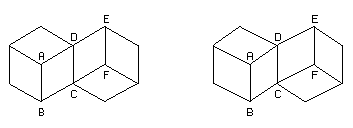Tumbling Blocks Illusions.
by Donald E. Simanek.The figure at the left, below, shows part of a pattern that quilters call the "tumbling blocks". Its illusory aspect is due to our mental inclination to interpret it as an isometric drawing of square panels seen in perspective, forming either three faces of a solid cube seen from its outside, or three faces of a cube seen from the inside. In the figure we may cover the right half, and easily see the point A as an outside corner, or as an inside corner. The edge AB may be seen as a vertical edge nearer to us than edge CD, or farther from us than edge CD.

But when we view both adjacent blocks together something else is at work. If we see AB as nearer, we want to see EF as farther. If we see AB as farther, we want to see EF as nearer. It seems we or brain wants to interpret the lines ADE and BCF as unbroken parallel lines, and the figure AEBF as a plane. It's much harder to see both AB and EF as nearer than CD, which would force us to see ABCD and CDEF as two planes like the pages of Mach's open-book illusion.
Could it be that the illusion arises because the brain prefers to see the segments ADE and BCF as part of an unbroken straight line? Can we fool it into thinking otherwise?
At the upper right we have redrawn the figure to break those lines. Now we cannot see ABEF as a single plane, but we still have difficulty seeing it as two planes ABCD and CDEF making a large angle with each other. We still have difficulty making both AB and EF seem near at the same time.
This is an example of conflicting depth clues. Can stereo rendering help us to sort them out? Can we make a stereo pair of this illusion such that binocular disparity forces the interpretation that the brain is reluctant to make in a flat picture?
The two examples above are printed side by side. Therefore they may be viewed as a stereo pair, using either parallel or cross-eyed viewing. Which interpretation dominates when the pictures are viewed this way?The following examples may be viewed without optical aid. The left two of each panel are used for parallel-eye viewing, the right two for crossed-eye viewing. The center figure will always be the unaltered isometric view. In this version, the stereo disparity is such that lines AB and EF are both near. But the monocular clues still strongly oppose the binocular ones, and may overcome them.

Here we have increased the binocular disparity to make the depth sensation stronger. The brain cannot see these as perfect cubes, but as parallelepipeds. The faces are not seen as square, but as parallelograms. Still the viewer senses a conflict of clues, and monocular clues still may overcome binocular ones.

In this version we've removed all conflicts and contradictions. The binocular clues are consistent with just one interpretation, and that interpretation is consistent with all monocular clues. Now it's next to impossible to force the brain to see this in any of the ways the previous versions could be seen.

For those who have learned crossed-eye viewing, these same figures are shown below, enlarged. Since these fill a larger portion of the visual field, the binocular clues are stronger.



![]() Input and suggestions are welcome at
the address shown to the right. Please mention the specific page of interest.
Input and suggestions are welcome at
the address shown to the right. Please mention the specific page of interest.